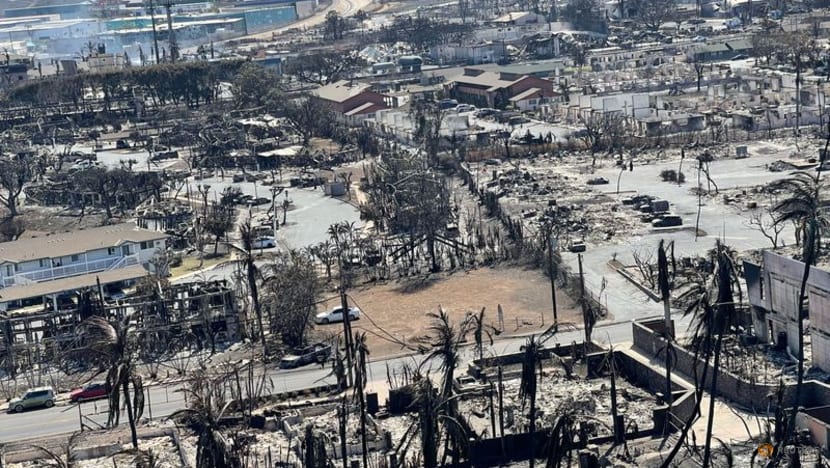How did the Maui fire start? Why Hawaii’s power lines are suspect

The shells of burned houses and buildings are left after wildfires driven by high winds burned across most of the town in Lahaina, Maui, Hawaii, on Aug 11, 2023. (Photo: Hawai'i Department of Land and Natural Resources/Handout via REUTERS)
It could take weeks or months to determine the cause of the blaze that destroyed the seaside Hawaiian town of Lahaina, one of the deadliest wildfires in US history.
But attention is already focusing on whether power lines owned by Hawaiian Electric Industries played a role, with the stock plunging more than 40 per cent since the fire began.
While many things could have provided the initial spark for the flames, which were fanned by high winds, electrical lines have a tragic history of triggering fires during wind storms.
WHAT CAUSED THE MAUI FIRE?
We don’t know. Hawaiian Electric, which operates the island’s power utility, has come under criticism for not shutting off power despite warnings of critical fire conditions due to predicted dry, gale-force winds.
Several wildfires erupted across Maui on Aug 8, as Hurricane Dora passed south of the Hawaiian islands. The company that day warned customers that winds had knocked down power lines in West Maui, where Lahaina is located, and near Kula, where another fire broke out.
The company’s press release, which said customers could face extended blackouts, did not mention fires. That said, many things can spark a blaze when winds are strong and vegetation is dry. Wildfires have been started by cigarette butts, trucks dragging chains along a road, and in one infamous case, pyrotechnics at a gender-reveal party.
HOW DO POWER LINES CAUSE WILDFIRES?
Several ways, usually involving wind. Strong enough gusts can tear down lines or knock over poles. They can also topple nearby trees or send branches flying into power lines, causing sparks.
Even when lines don’t fall, winds can cause them to sway into each other, again creating sparks and sending molten metal into the grass below.
WHAT’S THE HISTORY?
Power lines have repeatedly sparked deadly fires across the western US, particularly in California.
The state’s largest utility, PG&E, was driven into bankruptcy in 2019 after several devastating, wind-driven fires blamed on the company’s equipment, including the 2017 wine country fires north of San Francisco and the 2018 Camp Fire, which levelled the town of Paradise and killed 85 people.
Plaintiff law firms now working in Maui represented fire victims in a US$13.5 billion settlement with PG&E.
Related:
HOW CAN FIRES FROM POWER LINES BE PREVENTED?
Utilities have long-trimmed trees near power lines. But the string of deadly western fires, fuelled by years of drought, have forced the companies to try other tactics. They’ve started placing more power lines underground, and using protective coatings on overhead lines.
In California, Nevada and Oregon, utilities now also shut off power lines in advance of high winds during dry conditions. The practice, known as Public Safety Power Shutoffs, angers customers but likely prevents fires.
WHAT DOES IT MEAN FOR HAWAIIAN ELECTRIC?
Investor worries about Hawaiian Electric’s potential role in starting the Maui fires, which killed more than 90 people, triggered a selloff of the company’s stock.
On Aug 14, the company’s shares tumbled in their biggest one-day loss in 19 years.
Guggenheim Securities warned in a research note that given the size of the company — with a market capitalisation of about US$2.3 billion — and the possible liabilities if power lines started the fires, “it’s hard for us to imagine if the company will emerge from this tragic incident in its current form".
Some type of government intervention, such as municipalisation, could be the result, the New York-based investment research firm said.















